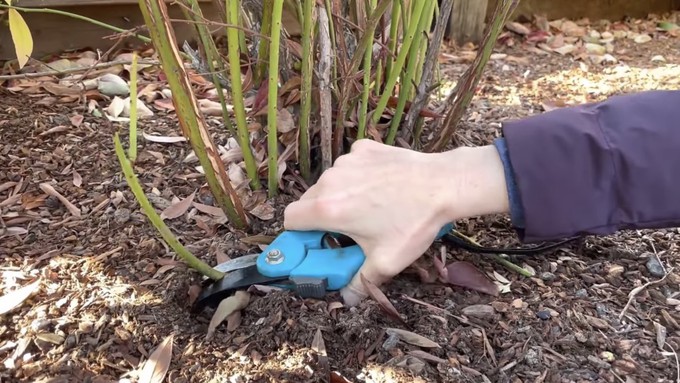
Planning, planting classes and videos offered by the area's master gardeners

Sacramento County master gardener Tamara Engel demonstrates how to prune a mature blueberry plant in a YouTube video. Screenshot from Sacramento County master gardeners' YouTube channel
We’re back to rain today (and likely Sunday) but even with wet conditions gardeners can still make progress the next several days toward their spring gardens. Choosing and starting seeds, for example, planning irrigation, or learning how to maximize planting spaces will all contribute to success.
The region’s master gardeners have three classes coming up that can help in those pursuits:
– “Gardening in Small Spaces,” 9 a.m. to noon, Wednesday, Feb. 8. This three-hour in-person class from the El Dorado County master gardeners will be held at the Cameron Park Community Center, 2502 Country Club Drive, Cameron Park. Master gardener Mike Pavlick will cover site location, design, raised bed options, container gardening and other methods that will allow anyone to have a vegetable garden in a small backyard setting. No pre-registration required. Information on the El Dorado master gardeners' events can be found here.
– “Growing Spring and Summer Vegetables,” Zoom online class, 9 a.m. to noon, Saturday, Feb. 11. El Dorado master gardener Zack Dowell will discuss garden plant selection, planting times, site selection, soil preparation, proper seed planting techniques, and pest management. Pre-registration is required to get the Zoom link. The registration link can be found under the class listing here: https://mgeldorado.ucanr.edu/Calendar/
– “Improving Water Efficiency in Your Garden,” in-person and Zoom workshop, 10:30-11:30 a.m. Saturday, Feb. 11. Presented by the Placer County master gardeners, it will include tips and resources for maximizing their water efficiency. Participants will gain water-wise ideas and visuals for transforming their landscape, organizers note. The in-person site is the Loomis Library, 6050 Library Drive, Loomis. The registration link for the simultaneous Zoom workshop can be found here.
Meanwhile, the Sacramento County master gardeners recently posted two helpful YouTube videos for this time of year: “Pruning Mature Blueberry Plants,” with master gardener Tamara Engel, and “Transplanting Nursery Plants for a Healthy Start” with master gardener Lisa Odom. Each is just 5 minutes, succinct and easy to repeat.
– Kathy Morrison
Comments
0 comments have been posted.Sacramento Digs Gardening to your inbox.
Sites We Like
Garden Checklist for week of July 21
Your garden needs you!
* Keep your vegetable garden watered, mulched and weeded. Water before 8 a.m. to reduce the chance of fungal infection and to conserve moisture.
* Feed vegetable plants bone meal, rock phosphate or other fertilizers high in phosphate to stimulate more blooms and fruiting. (But wait until daily high temperatures drop out of the 100s.)
* Don’t let tomatoes wilt or dry out completely. Give tomatoes a deep watering two to three times a week.
* Harvest vegetables promptly to encourage plants to produce more. Squash especially tends to grow rapidly in hot weather. Keep an eye on zucchini.
* Pinch back chrysanthemums for bushy plants and more flowers in September.
* Remove spent flowers from roses, daylilies and other bloomers as they finish flowering.
* Pinch off blooms from basil so the plant will grow more leaves.
* Cut back lavender after flowering to promote a second bloom.
* It's not too late to add a splash of color. Plant petunias, snapdragons, zinnias and marigolds.
* From seed, plant corn, pumpkins, radishes, winter squash and sunflowers.